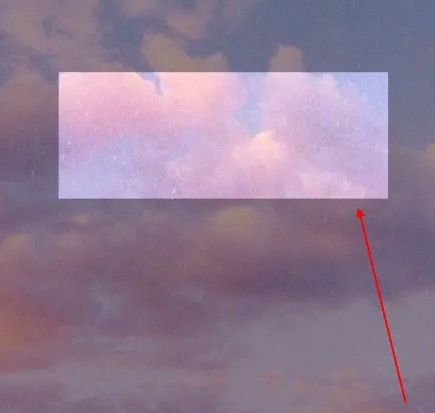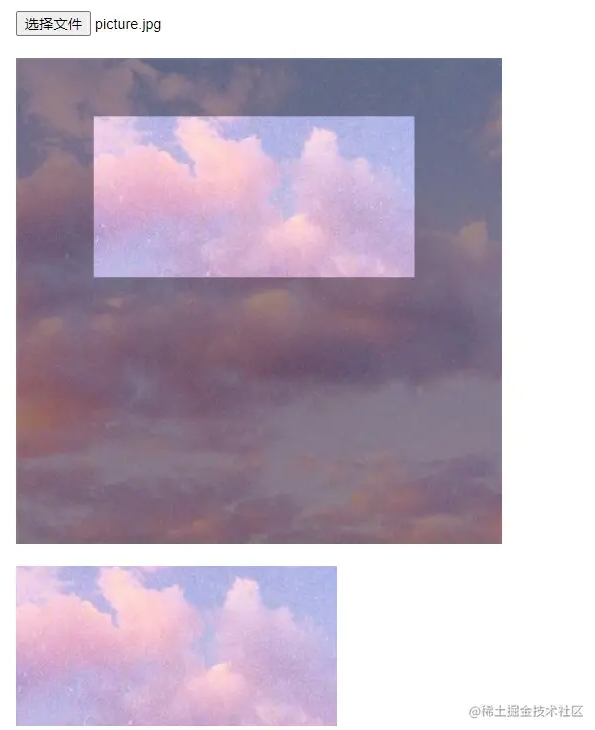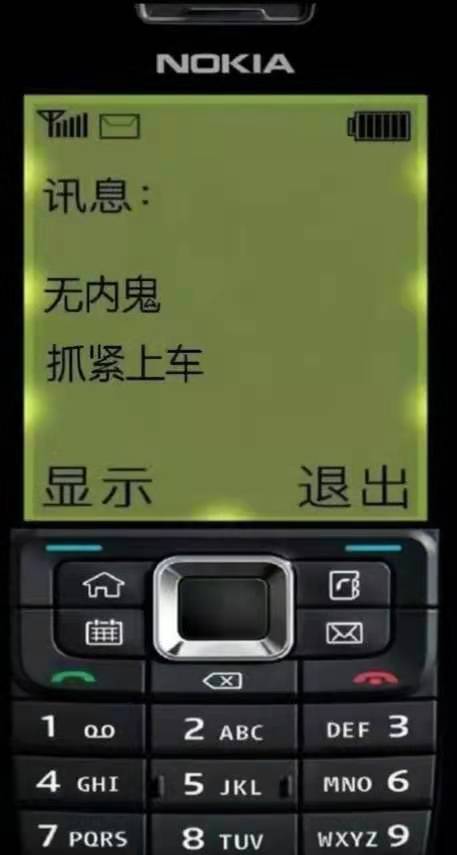這裡給大家分享我在網上總結出來的一些知識,希望對大家有所幫助 思路分析 在開始動手之前,分析一下整個功能的實現過程: 根據圖片大小創建 canvas1 畫布,並將原圖片直接定位在 canvas1 上; 在畫布上添加一個蒙層,以區分當前 canvas 圖像是被裁剪的原圖像; 在蒙層上方,對裁剪區域(鼠 ...
這裡給大家分享我在網上總結出來的一些知識,希望對大家有所幫助
思路分析
在開始動手之前,分析一下整個功能的實現過程:
-
根據圖片大小創建
canvas1畫布,並將原圖片直接定位在canvas1上; -
在畫布上添加一個蒙層,以區分當前
canvas圖像是被裁剪的原圖像; -
在蒙層上方,對裁剪區域(滑鼠移動形成的矩形範圍)再次進行圖像繪製;
-
獲取裁剪區域的數據,並將該數據定位到另一個
canvas畫布上。
實現過程
準備工作
首先,編寫所需的 HTML 結構並獲取對應元素。
<body>
<!-- 上傳文件 -->
<input type="file" id="imageFile" accept="image/*">
<!-- 保存被裁剪的原圖像,初始樣式需要設置 display: none -->
<div class="canvasContainer1">
<canvas id="canvas1"></canvas>
</div>
<!-- 保存裁剪區域的圖像,初始樣式需要設置 display: none -->
<div class="canvasContainer2">
<canvas id="canvas2"></canvas>
</div>
</body>
<script>
const imageFile = document.querySelector('#imageFile');
const canvasContainer1 = document.querySelector('.canvasContainer1');
const canvasContainer2 = document.querySelector('.canvasContainer2');
const canvas1 = document.querySelector('#canvas1');
const canvas2 = document.querySelector('#canvas2');
const ctx = canvas1.getContext('2d');
const ctx2 = canvas2.getContext('2d');
const imageBox = new Image(); // 創建一個存放圖片的容器
</script>
繪製原圖像
我們需要監聽 input 元素的 change 事件,以獲取上傳圖片的相關參數,這裡主要是為了獲取圖片的寬度和高度。
我們創建一個 FileReader() 對象並監聽其 load 事件。load 事件在讀取操作成功後立刻執行,在這個方法中我們就可以獲取圖片的寬高。
function init() {
imageFile.addEventListener('change', handleFileChange, false); // 監聽圖片上傳事件。
}
function handleFileChange(e) {
const imgFile = e.target.files[0]; // 獲取上傳的圖片對象。
const reader = new FileReader();
reader.onload = function(e) {
const imgSrc = e.target.result; // 圖片文件的 base64 編碼格式。
imageBox.src = imgSrc; // 把圖片放入 img 容器。
// 等圖片載入完成後,獲取圖片的寬高。
imageBox.onload = function () {
const imgWidth = this.width, imgHeight = this.height;
console.log(imgWidth, imgHeight);
}
}
if (imgFile) {
reader.readAsDataURL(imgFile); // 讀取圖片文件,讀取完成才能獲取 result 屬性。
}
}
init();

canvas1 畫布,並使用 drawImage() 方法將上傳的圖片直接定位到 canvas1 當中。function handleFileChange(e) {
const imgFile = e.target.files[0]; // 獲取上傳的圖片對象。
const reader = new FileReader();
reader.onload = function (e) {
const imgSrc = e.target.result; // 圖片的 base64 編碼。
imageBox.src = imgSrc; // 把上傳的圖像放入 img 容器。
// 圖片載入完畢後執行
imageBox.onload = function () {
// 獲取圖片的寬高。
const imgWidth = this.width, imgHeight = this.height;
console.log(imgWidth, imgHeight);
// 創建 canvas 畫布並繪製圖片。
generateCanvas(canvasContainer1, canvas1, imgWidth, imgHeight);
ctx.drawImage(imageBox, 0, 0, imgWidth, imgHeight);
}
}
if (imgFile) {
reader.readAsDataURL(imgFile); // 將當前file讀取成DataURL
}
}
// 根據 width 和 height 創建 canvas 畫布。
function generateCanvas(container, canvas, width, height) {
container.width = width + 'px';
container.height = height + 'px';
canvas.width = width;
canvas.height = height;
container.style.display = 'block'; // 顯示 canvas 區域。
}

可以看到原圖像已經成功被繪製,接下來就可以開始動態繪製截圖區域了。
繪製截圖區域
在這個過程中,我們需要分別監聽 imageBox 容器(原圖像)上的 mousedown、mousemove 和 mouseup 事件,這些事件的作用如下:
mousedown事件:記錄開始截圖的位置,並開始監聽mousemove和mouseup事件。mousemove事件:監聽滑鼠的偏移量,以計算裁剪區域的寬度和高度。mouseup事件:截圖結束,註銷監聽mousedown和mousemove事件,並繪製裁剪區域。
let startPosition = []; // 記錄滑鼠點擊(開始截圖)的位置。
let screenshotData = []; // 保存截取部分的相關信息。
function init() {
// 監聽滑鼠點擊事件。
canvas1.addEventListener('mousedown', handleMouseDown, false);
}
// 記錄滑鼠點擊(開始截圖)的位置,並監聽相關事件。
function handleMouseDown(e) {
startPosition = [e.offsetX, e.offsetY];
canvas1.addEventListener('mousemove', handleMouseMove, false);
canvas1.addEventListener('mouseup', handleMouseUp, false);
}
// 監聽滑鼠的偏移量,以計算裁剪區域的寬度和高度。
function handleMouseMove(e) {
// 獲取裁剪區域的寬度和高度。
const { offsetX, offsetY } = e;
const [startX, startY] = startPosition;
const [rectWidth, rectHeight] = [offsetX - startX, offsetY - startY];
console.log('rect', rectWidth, rectHeight);
// 保存裁剪區域的相關信息。
screenshotData = [startX, startY, rectWidth, rectHeight];
}
// 註銷監聽事件等後續操作。
function handleMouseUp() {
canvas1.removeEventListener('mousemove', handleMouseMove, false);
canvas1.removeEventListener('mouseup', handleMouseUp, false);
}
在 handleMouseMove 函數中,我們已經獲取了裁剪區域的寬高,也就是生成截圖的寬高。
接下來,我們需要在原圖像上展示出我們所裁剪的區域,也就是這個效果:

可以看到,原圖像的上方、裁剪區域下方會覆蓋一層半透明黑色蒙層,它的作用是區分原圖層和裁剪部分圖層。所以我們需要在繪製截圖區域之前,添加一層蒙層。
註意,在已有內容的 canvas 畫布上進行再次繪製之前,需要先清除整個畫布的內容。 這裡通過 clearRect() 方法清除 canvas1 畫布上的所有內容,並添加蒙層。
我們繼續來補充 handleMouseMove 和 handleMouseUp 函數中的邏輯:
const MASKER_OPACITY = 0.4;
function handleMouseMove(e) {
// 獲取裁剪區域的寬度和高度。
const { offsetX, offsetY } = e;
const [startX, startY] = startPosition;
const [rectWidth, rectHeight] = [offsetX - startX, offsetY - startY];
console.log('rect', rectWidth, rectHeight);
// 保存裁剪區域的相關信息。
screenshotData = [startX, startY, rectWidth, rectHeight];
// 再次繪製前,清理 canvas1 畫布上的內容。
const { width, height } = canvas1;
ctx.clearRect(0, 0, width, height);
// 在 canvas1 畫布上繪製蒙層。
drawImageMasker(0, 0, width, height, MASKER_OPACITY);
// 繪製截圖區域。
drawScreenShot(width, height, rectWidth, rectHeight);
}
// ...
// 繪製圖片蒙層,填充範圍和顏色,以便區分原圖層和裁剪部分圖層。
function drawImageMasker(x, y, width, height, opacity) {
ctx.fillStyle = `rgba(0, 0, 0, ${opacity})`;
ctx.fillRect(0, 0, width, height);
}
// 繪製裁剪的矩形區域。
function drawScreenShot(canWidth, canHeight, rectWidth, rectHeight) {
// 在源圖像外繪製新圖像,只有源圖像外的目標圖像部分會被顯示,源圖像是透明的。
ctx.globalCompositeOperation = 'destination-out';
ctx.fillStyle = '#2c2c2c';
ctx.fillRect(...startPosition, rectWidth, rectHeight);
// 在現有畫布上繪製新的圖形。
ctx.globalCompositeOperation = 'destination-over';
ctx.drawImage(imageBox, 0, 0, canWidth, canHeight, 0, 0, canWidth, canHeight);
}
然後,當我們放開滑鼠(結束截圖動作)時,除了註銷對 mousedown 和 mousemove 事件的監聽,還需要將所得的裁剪區域的圖像放入另一個 canvas 中。
在繪製新圖像的過程中,我們需要使用以下方法:
- getImageData():讀取
canvas上的內容,返回一個ImageData對象,包含了每個像素的信息。 - putImageData():將
ImagaData對象的數據放入canvas中,覆蓋canvas中的已有圖像。
function handleMouseUp() {
canvas1.removeEventListener('mousemove', handleMouseMove, false);
canvas1.removeEventListener('mouseup', handleMouseUp, false);
// 開始繪製截圖區域圖片。
drawScreenshotImage(screenshotData);
// 如果裁剪得到新圖像後,不希望保留原圖像,可以設置以下屬性。
// canvasContainer1.style.display = 'none';
}
// 在新容器 canvas2 上繪製新圖像。
function drawScreenshotImage(screenshotData) {
// 獲取 canvas1 的數據。
const data = ctx.getImageData(...screenshotData);
// 創建 canvas2 畫布。
generateCanvas(canvasContainer2, canvas2, screenshotData[2], screenshotData[3]);
// 每次繪製前,都先進行清除操作。
ctx2.clearRect(...screenshotData);
// 將 canvas1 的數據放入 canvas2 中。
ctx2.putImageData(data, 0, 0);
}
經過以上步驟,就可以實現我們所需的效果





